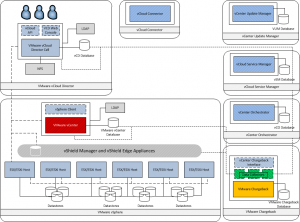During VMworld Chris Colotti and I presented quite a few group discussions on VMware vCloud. During these discussions some people were amazed to find out how many components/products are involved in making up the vCloud environment. When planning on building a VMware vCloud, you are not just installing vCloud Director and pointing it to vSphere, you are designing/building a whole Ecosystem.
The list below shows which components are used in building a full vCloud environment. They are listed in order of priority.
- vSphere ESXi
- vCenter
- vCloud Director
- vShield Manager
- vCenter Chargeback
- Vcenter Update Manager
- vCenter Orchestrator
- vCloud Service Manager
- vCloud Connector
So why are these components important? When designing a vCloud environment, you need to take into consideration the availability of certain components, like vCenter for example. This is no longer a management tool that is used to manage your virtual infrastructure. This is a critical component of your vCloud environment passing through all the operational commands a consumer initiates using vCloud Director. How do you protect vCenter? There are 6 databases in a vCloud Ecosystem. How do you protect all the databases? Every component shown above with the exception of ESXi and vCloud Connector have a database that have relationships with each other. If you loose a vCenter database and you restore a database from two hours ago, how does vCloud Director know what to do now, or Chargeback for example? These are all considerations when carrying out a vCloud design and implementation.
The diagram below, shows how the components fit together. This demonstrates the criticality of some of the vCloud components. Click on the diagram to enlarge.
By looking at the diagram, you can see the complexity of how the components all link together. Chargeback for example runs data collectors that not only communicate through the vCloud and vCenter API’s, but also have direct connections to the database to gather its metrics. vCenter must be resilient in terms of providing the application services and the database. Perhaps using Heartbeat is an option?
I hope this article has given you some food for thought when designing your vCloud environment. As I said earlier its not just about vCloud Director.
I am currently working on a project along with Chris Colotti within VMware for us to develop a vCloud infrastructure BC/DR strategy. We are always looking for good use cases from people, so if you have any unusual setups please tell us by using the comments section below.


[…] https://www.davidhill.co/2011/10/vcloud-ecosystem-components-explained/http://www.chriscolotti.us/vmware/vcloud/components-for-a-vcloud-deployment/ (A bit older was my original cut at what Dave has now) […]
[…] I wrote an article about the overall "vCloud EcoSystem", and what components were required to build out a full Cloud environment. The article briefly […]
[…] Eco-system components, for example Chargeback and vCenter Orchestrator. See related blog articles: vCloud Ecosystem components explained and vCloud Ecosystem components explained part […]
[…] have written previously about the vCloud Ecosystem (part1) (part2), which combines multiple products to make up a vCloud environment. What I want to cover in […]